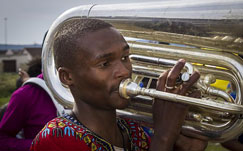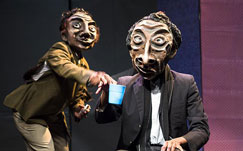South Africans show passion for the arts
17 July 2015
The popularity of the National Arts Festival has been reaffirmed with the release of
this year's attendance figures, which show a "significant" increase in attendance in
2015. This increase comes despite expectations that attendance might flatten after
last year's bumper 40th birthday programme.
"The total number of tickets issued increased to 241 116, representing 6.9% growth
over 2014. Even more heartening is that, within this number, there are more paid-
for tickets than ever before with the rand value of tickets bought for festival shows
up by 18%," said Tony Lankester, the festival's chief executive.
"While the festival continues to offer great value and plenty of free entertainment,
audiences are showing that they respond to quality work positively, and are
prepared to put their money where their passion is – even in a tough economic
climate. This augers well for the arts sector, and is a ringing endorsement for the
talent and hard work of our artists."
On the main programme, jazz and theatre each accounted for roughly one third of
sales, with the remaining third being split between dance, comedy, music and some
of the niche genres.
"The quickest selling show was Irish comedian Dylan Moran, whose three
performances in the Guy Butler Theatre sold out faster than any show we've seen in
recent years. We also had a massive response to Thandiswa Mazwai, Beatenberg,
Ray Phiri and MiCasa, as well as to Chester Missing and Standard Bank Young Artist
Award winner for theatre, Christiaan Olwagen's
A Doll's House,"
Lankester said.
Sold out houses
"The list of main productions that had sold out houses is long – but includes
Three Blind Mice, the Baxter Theatre's remake of Barney Simon's
Born in the RSA and Pieter Dirk Uys's
A Part Hate, A Part
Love. It was also great to see former Victoria Girls High School head
girl
Nomfundo Xaluva perform to a sold-out crowd on the Standard Bank Jazz Festival
stage."
Both the Symphony Concert and the Gala Concert also played to packed houses.
Artistic director Ismail Mahomed said he was delighted with the response to the
programme on offer. "Audiences are responding well to both fresh approaches to
classic works (
Hamlet,
A Doll's House,
Born in the
RSA) and exciting new work (
Three Blind Mice,
A Voice I
Cannot Silence)," he said.
Mahomed also noted the success of some of the international work and
collaborations on the programme – notably The Ayrshire Fiddle Orchestra,
The Dog Days are Over and
Red Earth Revisited.
The Fringe
Comedy and theatre continued to dominate the massive Fringe programme,
accounting for 38.1% and 25.2% of total Fringe sales respectively.
"If you scan the list of top productions on the Fringe it is still
dominated by comedy
with great performances by Loyiso Gola, Rob van Vuuren in
WhatWhat
and a series of top-performing productions from the Followspot Collective
(
Big Boys II,
Big Girls and
Bon Soir),"
Mahomed said. Theatre and dance held their own, however, with
Tobacco And
The Harmful Effects Thereof,
Blue,
We Didn't Come To
Hell For The Croissants and
Woza Albert! all doing well both
critically and at the box office.
Lankester pointed to the Festival's agreement with the National Lottery as a key
driver of the success of the Fringe.
"Through this partnership we are able to keep the Fringe stage open to all to
participate, with a very low economic barrier to entry and with no curation or
selection taking place. This makes it the country's biggest and most democratic
stage, and saw around 300 productions and 50 visual artists make the trip to
Grahamstown," he said.
"The Fringe is
very competitive and, once again, we saw productions that combined
excellent work with solid marketing doing the best. This can be a tough but a very
useful experience for young theatre practitioners."
Behind the numbers, Lankester pointed to a number of other features of this year's
festival that of which organisers were proud:
- Growth in the number of tickets sold online and through the festival's mobile
app, which accounted for 22% of all sales this year.
- The introduction of a free "Festival Hopper" service, run by a local taxi
operator, to move festivalgoers between venues more efficiently.
- The staging of two works (Waltz and Waterline)
from Grahamstown community-based companies supported by the festival's
Creative City project and Makana Arts Academy partnership with the European
Union, both of which won Standard Bank Ovation Awards.
- The 28 visiting international producers who used the festival as a
"shopping
ground" to look for work to tour to their festivals and institutions.
- Productions from artists emanating from more than 30 countries on the
programme – including Angola, Belgium, Senegal, Spain, India, Ireland, the
Netherlands, Canada, Colombia, Benin and Zimbabwe.
- Employment of more than 400 freelance and contract staff, predominantly from
the ranks of the unemployed in Grahamstown and student interns, to work across
the event in different capacities.
"We now get down to planning the 2016 festival, which will run from 30 June until
11 July 2016," Lankester concluded. "This year will be a tough act to follow, but
we're confident we can rise to the challenge."
The annual National Arts Festival takes place during the winter holiday in the small
academic town of Grahamstown, in Eastern Cape. This year it ran from 2 to 12 July.
Source: National
Arts Festival
 Moments from the street parade in Joza, Grahamstown on 11 July 2015, at the National Arts Festival. To mark the end of the festival people gather with floats, instruments and art to celebrate. (Image: CuePix, Jane Berg)
Moments from the street parade in Joza, Grahamstown on 11 July 2015, at the National Arts Festival. To mark the end of the festival people gather with floats, instruments and art to celebrate. (Image: CuePix, Jane Berg)
 Khaya Kondile and Mzwanele Jodwana perform during a dress rehearsal for Rob Murray's production Waterline, in Grahamstown on 1 July 2015, at the National Arts Festival. Murray's new mask work is a fictionalised and satirical look at Grahamstown's water crisis. (Image: CuePix, Mia van der Merwe)
Khaya Kondile and Mzwanele Jodwana perform during a dress rehearsal for Rob Murray's production Waterline, in Grahamstown on 1 July 2015, at the National Arts Festival. Murray's new mask work is a fictionalised and satirical look at Grahamstown's water crisis. (Image: CuePix, Mia van der Merwe)







